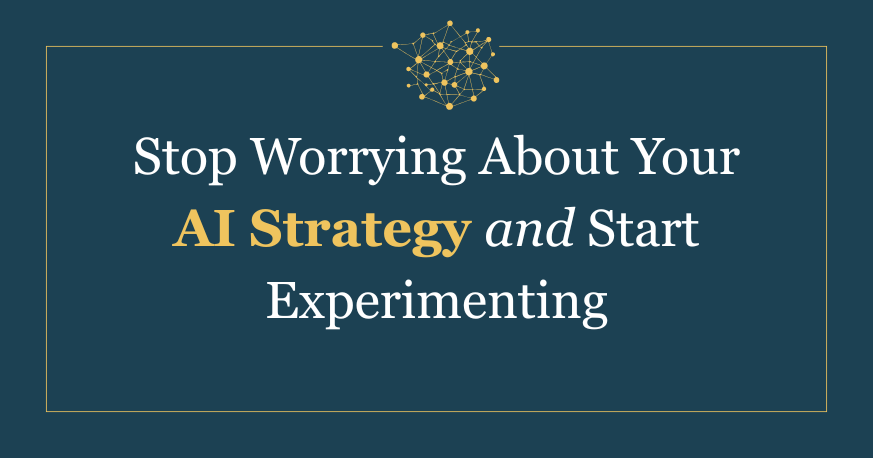Stop Worrying About Your AI Strategy and Start Experimenting
“What’s your AI strategy?”
By now, every startup founder has probably heard this question. Consultants are selling drag-and-drop AI strategies. Competitors are bragging about their AI-driven everything. And investors are asking about your AI approach in pitch meetings.
But here’s the simple truth: for most startups, developing an AI “strategy” is getting ahead of yourself. AI, like cloud computing or multifactor authentication before it, is likely to impact every part of your business—from accounting and HR to product development and logistics. Planning a whole umbrella strategy is going to make your every business challenge look like a nail waiting for the AI hammer.
Instead, consider taking a bottom-up approach. Start with individual people or departments. Start with a specific problem that you want to solve, or a part of the business where you need to save time or resources. Just start. Then, share your results, apply what you learned, refine your approach, and keep going. Here are five tips for getting started, and a big question to keep in mind.
1. Start Small
No need to boil the ocean with your AI anti-strategy; in fact, the smaller your experiments, the better. Start with a problem or challenge you may already have a headstart on, so you can vet the results AI gives you. AI can even help you break down a bigger challenge (like preparing a board package) into smaller, actionable parts.
AI adoption works best as an ongoing experiment, not a one-time implementation. Your team needs training, yes, but more importantly, they need permission to try things, fail fast, and iterate. Employees need to push their comfort levels with new technology. But that happens through hands-on experience, not training sessions. Give them permission to use AI tools, provide clear boundaries for safe experimentation, and create feedback loops for continuous improvement.
2. Start Where You Are.
Survey data aggregated by The Federal Reserve shows that 20-40% of professionals are already using AI in their day-to-day work, often without formal company policies or grand strategies. They’re not waiting for permission; they’re flexing their curiosity.
This is a great place to start. Chances are good there’s at least one early adopter in your ranks. Enlist the folks who are game with a challenge to improve the business, their department, or their own day-to-day work in some small, measurable way. For example:
Marketing teams are using AI for creative ideation, persona research, trend analysis, content creation, campaign planning, and SEO.
Sales is leveraging AI for customer insights, prospecting strategies, scheduling, providing feedback on sales calls, and customizing presentations.
Operations teams can optimize inventory and logistics by using AI to process and synthesize data, respond to supply chain disruptions, or forecast demand.
Executive teams use AI to vet their high-level decision-making and complex problem-solving, running scenarios that would take weeks to model manually.
As Clorox discovered when it rolled out a mandate to integrate AI as part of a digital transformation, you have to let teams identify their pain points and test whether AI can address them. Create a controlled testing environment where a small group can experiment safely. Think of it as AI office hours: designated time and space for trying new tools without risking production systems. Be flexible and allow each team to experiment in ways that align with their specific needs. Then create opportunities to share what you’re learning so you can expand on what works.
3. Start with a Need
When the hype cycle is high, it’s dangerously easy to adopt a technology for its own sake (we see you, Yammer.) But you don’t need to make this mistake: there are lots of motivations to bring AI into your daily operations. Here are a few obvious ones.
Save time and costs. AI excels at outlining, summarizing, and ideation, just the kind of work that takes a lot of time or burns through employee hours. Your marketing manager can generate content campaigns in minutes instead of hours. Your sales team can summarize client calls automatically. Your product team can upload user data or feature requests and instantly detect patterns.
Expand your research capabilities. AI gives small teams access to broader datasets and market intelligence that previously required dedicated research staff. You can analyze competitor strategies, customer sentiment, and industry trends without hiring analysts or combing through your own (or other people’s) data, looking for highlights.
Boost productivity. Here’s your chance to offload some of that repetitive, pedantic work—like data entry, basic reporting, or scheduling—that you’d normally save for your post-lunch, food-coma self. Without all that busy work, you’re freed up to focus on things that move the company forward.
Become more consistent. By using AI to apply a process, you’re ensuring you use that exact same process every time. This can be a huge win for small companies that haven’t yet established a lot of structure or uniformity. Whether you’re creating brand-formatted slide decks or running reports, AI will hold you to the standards you give it.
Model the future. AI is a terrific scenario planner, especially if you provide it with contextual prompts and proprietary data. What happens if you expand to three new markets? How do different pricing models affect customer lifetime value? AI lets you test strategies without risking real resources.
4. Once You’ve Started, Be Specific
Generic AI gives generic results. AI that understands your industry, customers, and voice becomes 10X more useful. You’ll want to train your AI on your custom data, tone, and approach (while being mindful of the privacy guardrails, below.) Make sure you’re using vetted data and that you document your process for aggregating that data.
For example, when crafting prompts, be specific. Instead of “analyze our sales data,” try saying, “Pretend you’re our CFO preparing for a board report on Q3 performance.” Include roles, context, industry, and target audience(s). When asking AI to analyze large data sets, ask it to explain its thinking in a step-by-step way. When researching new markets, ask AI to provide sources for its analysis and suggestions.
5. Don’t Forget the Guardrails.
Never feed AI sensitive or proprietary data unless you’re certain about privacy protections. Pro tip: if you’re using the free version of anything AI, your privacy probably isn’t a priority. Check with your legal and IT teams if you’re not sure.
Vet your data before you upload it to AI. As a Wall Street Journal editorial noted, “Poor data quality—incomplete, biased or unstructured—affects AI performance in the same way it can have an impact on any other technology. If you don’t have good data, you can have great strategic intent, but you won’t be able to execute it. The strategy will simply divert attention from what the company really needs to do.”
Always verify AI’s outputs. Demand citations, ask for explanations, and check the work. AI hallucinations are real, and it only takes one flub to risk losing your credibility and your audience’s trust.
Remember that AI is a tool, not a team member, and it can’t yet replace some key human functions. As A16Z notes: “genAI is not yet ready to replace two absolutely crucial capabilities in professional services: judgment and sales (although both can be AI-assisted). At the end of the day, it will still be up to the seasoned professional to win new business, sign their name next to a recommendation (even if said recommendation is 90% automated via AI), and stand by it. Founders must be wary of this.”
Don’t let AI efficiency gains compromise service quality. Recent missteps by companies like Duolingo and Klarna demonstrate the risks of treating AI as a strategy rather than a tool. When executives touted the “cutting-edge cost savings” from replacing human employees with chatbots, they faced swift customer backlash and were forced to rehire staff to restore the service standards their customers demanded.
The Big Question
It’s worth asking: what might we lose when humans stop doing the grunt work?
The answer is that we don’t know yet. If your team stops manually analyzing customer feedback, will they lose the intuition to spot emerging trends? If AI handles all your financial modeling, will your finance team stop understanding the underlying business mechanics?
The secondary effects, the failure points, the institutional knowledge that comes from understanding every lever in your business…these are still emerging. The answer isn’t to avoid AI, it’s to stay conscious of these tradeoffs and maintain human expertise in critical areas. “People in finance tend to want to have a new tool,” says Conor Grennan, Chief AI architect at NYU Stern. “But this is not a new tool. This is a new way of thinking and working.”
The startups winning with AI aren’t the ones with the most sophisticated strategies. They’re the ones with the most experiments running, the clearest guardrails, and the strongest feedback loops. The best AI strategy is the one you don’t need to think about because it’s just how work gets done. Go get started.



